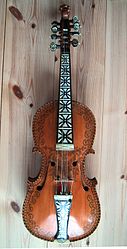Hardingfele
 |
|
| Classification | |
|---|---|
| Related instruments | |
A Hardanger fiddle (or in Norwegian: hardingfele) is a traditional stringed instrument used originally to play the music of Norway. In modern designs, this type of fiddle is very similar to the violin, though with eight or nine strings (rather than four as on a standard violin) and thinner wood. Four of the strings are strung and played like a violin, while the rest, aptly named understrings or sympathetic strings, resonate under the influence of the other four.
The Hardingfele is used mainly in the southwest part of Norway, whereas the ordinary violin (called flatfele - 'flat fiddle' or vanlig fele - 'common fiddle') is found elsewhere. The Hardingfele is used for dancing, accompanied by rhythmic loud foot stomping. It was also traditional for the fiddler to lead the bridal procession to the church.
The instrument often is highly decorated, with a carved animal (usually a dragon or the Lion of Norway) or a carved woman's head as part of the scroll at the top of the pegbox, extensive mother of pearl inlay on the tailpiece and fingerboard, and black ink decorations called 'rosing' on the body of the instrument. Sometimes pieces of bone are used to decorate the pegs and the edges of the instrument.
The earliest known example of the hardingfele is from 1651, made by Ole Jonsen Jaastad in Hardanger, Norway. Originally, the instrument had a rounder, narrower body. Around the year 1850, the modern layout with a body much like the violin became the norm.
...
Wikipedia
